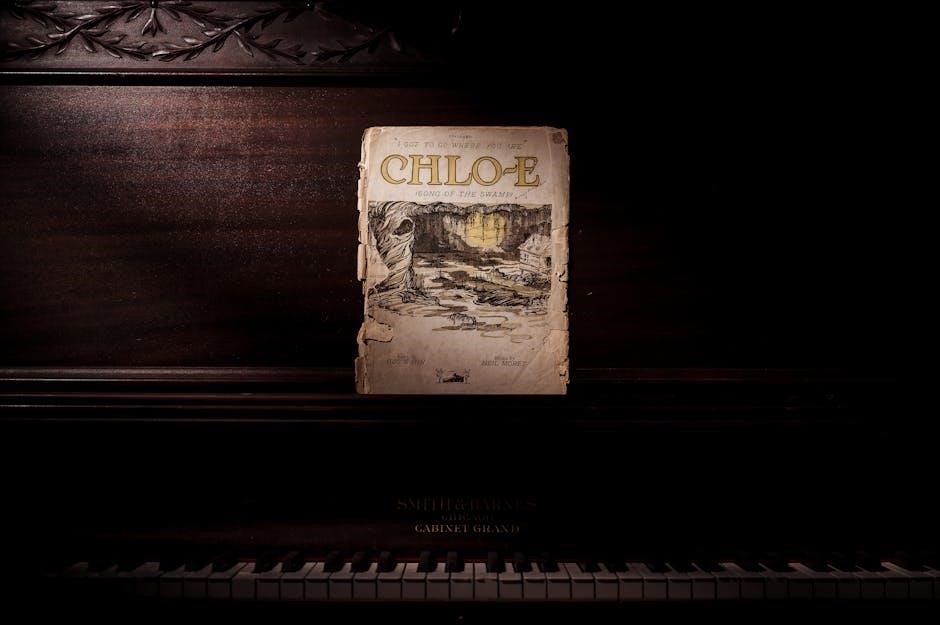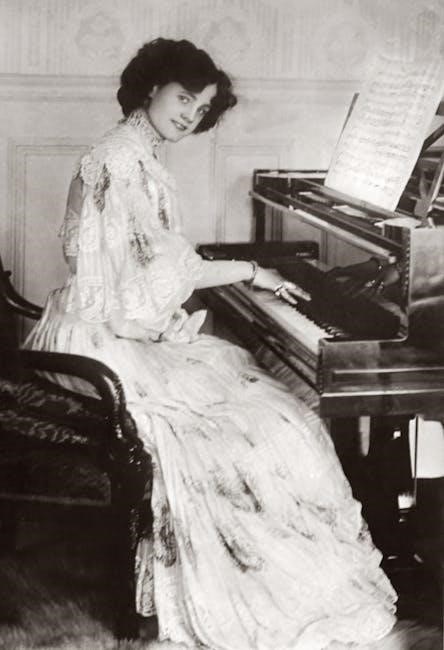Canon in D Piano Sheet Music: Easy & Free PDF Resources
Discover a wealth of accessible and cost-free resources for learning Canon in D on the piano. Explore our curated collection of easy piano arrangements and free PDF sheet music. Whether you are a beginner or intermediate player‚ find the perfect version to suit your skill level and musical aspirations.
Canon in D‚ composed by Johann Pachelbel in the Baroque era‚ stands as one of the most recognized and beloved pieces of classical music. Its enduring appeal lies in its simple yet elegant structure‚ characterized by a repeating bass line and a captivating melody that weaves through variations. This timeless piece has transcended its classical origins‚ finding its way into countless weddings‚ film scores‚ and popular culture references.
For aspiring pianists‚ Canon in D offers an excellent entry point into classical music. Its relatively straightforward harmonic progression and melodic contours make it accessible to beginners‚ while its inherent beauty and expressive potential provide ample challenges for more advanced players. The availability of numerous easy piano arrangements and free PDF sheet music online further enhances its appeal to learners of all levels.
This article serves as a comprehensive guide to exploring the world of Canon in D piano sheet music. We’ll delve into its popularity‚ examine beginner-friendly versions‚ discuss intermediate arrangements‚ and provide valuable tips for mastering this iconic piece. We will also uncover resources for finding free sheet music online and learning through tutorials and apps.
Why Canon in D is Popular
Canon in D’s enduring popularity stems from a confluence of factors that resonate deeply with listeners across generations. Its simple harmonic structure‚ built around a repeating bass line and a series of elegant melodic variations‚ creates a sense of calm‚ order‚ and beauty. This inherent simplicity makes it easily accessible and enjoyable‚ even for those without formal musical training.
The piece’s versatility further contributes to its widespread appeal. Canon in D lends itself well to various arrangements and interpretations‚ from solo piano to orchestral performances. Its adaptable nature has allowed it to be incorporated into countless weddings‚ ceremonies‚ and film soundtracks‚ solidifying its place in popular culture. The piece evokes feelings of love‚ celebration‚ and nostalgia‚ making it a fitting accompaniment to life’s most significant moments.
Moreover‚ the availability of easy piano arrangements and free sheet music has democratized access to this iconic piece. Aspiring pianists of all levels can readily learn and perform Canon in D‚ fostering a sense of accomplishment and connection to a timeless musical masterpiece. Its popularity is a testament to its enduring beauty and its ability to touch the hearts of listeners worldwide.
Easy Piano Arrangements: Overview
Easy piano arrangements of Canon in D are specifically designed to make this iconic piece accessible to beginner pianists. These arrangements typically simplify the original composition by reducing the complexity of the chords‚ melodies‚ and rhythms. This allows learners to focus on developing fundamental piano skills while still experiencing the beauty and satisfaction of playing Canon in D.

Key features of easy piano arrangements often include simplified harmonies‚ using basic triads and inversions instead of more complex chords. The melody is usually presented in a clear and straightforward manner‚ often sticking to single notes or simple two-note chords. Rhythmic patterns are also simplified‚ avoiding complex syncopation or challenging time signatures. Fingerings are often included to guide beginners in proper hand positioning and technique.
These arrangements serve as an excellent starting point for novice pianists who want to learn a recognizable and rewarding piece; By mastering an easy version of Canon in D‚ beginners can build confidence‚ develop their musical skills‚ and gain a deeper appreciation for the beauty and elegance of classical music. Furthermore‚ playing a simplified arrangement can motivate learners to progress to more challenging versions as their skills improve.
Finding Free PDF Sheet Music Online
The internet offers a plethora of resources for finding free PDF sheet music of Canon in D‚ catering to various skill levels. Several websites specialize in providing free sheet music for piano‚ often including multiple arrangements of popular pieces like Canon in D. These sites may offer versions specifically designed for beginners‚ intermediate players‚ or even advanced pianists.
To find free PDF sheet music‚ start by using search engines with specific keywords such as “free Canon in D sheet music piano‚” “easy piano sheet music Canon in D PDF‚” or “Canon in D beginner piano sheet music free.” Explore websites dedicated to sheet music archives‚ online piano tutorials‚ and communities of musicians who share their arrangements. Be sure to preview the sheet music before downloading to ensure it matches your skill level and preferences.

Many websites offer user ratings and reviews of sheet music arrangements‚ which can help you determine the quality and accuracy of the transcription. Some sites may also offer accompanying audio recordings or video tutorials to aid in learning the piece. Remember to respect copyright laws and only download sheet music that is explicitly offered for free or is in the public domain.
Beginner-Friendly Versions: Key Features
Beginner-friendly versions of Canon in D piano sheet music are specifically designed to make learning this beautiful piece accessible to novice players. These arrangements typically incorporate several key features to simplify the music without sacrificing its essence. One common feature is the use of simplified harmonies‚ often focusing on basic chords and avoiding complex voicings.
Another key aspect is the reduction in the number of notes played simultaneously‚ creating a clearer and less cluttered sound. The melody is often emphasized‚ while the accompaniment is simplified to support the main theme without overwhelming the beginner. Additionally‚ beginner-friendly versions often include helpful fingerings to guide the player and promote proper technique.
The tempo may also be indicated at a slower pace‚ allowing beginners to learn the notes and rhythms more accurately. Furthermore‚ these arrangements often feature larger font sizes and clear notation‚ making the sheet music easier to read. Key signatures and time signatures are typically kept simple‚ avoiding complex sharps or flats that can be challenging for beginners to grasp. Ultimately‚ the goal is to provide an enjoyable and achievable learning experience for those new to the piano.
Intermediate Level Arrangements
Intermediate level arrangements of Canon in D offer a more challenging and nuanced experience for pianists who have developed some foundational skills. These versions typically feature richer harmonies‚ incorporating more complex chords and voicings that add depth and texture to the music. The arrangements often include more intricate accompaniment patterns‚ requiring greater dexterity and coordination.
Intermediate players will encounter more varied rhythms and syncopation‚ demanding a stronger sense of timing and musicality. Fingerings may be less explicitly marked‚ encouraging players to develop their own solutions and interpretations. Dynamic markings and articulation are often more detailed‚ prompting a greater awareness of musical expression and phrasing.
Furthermore‚ intermediate arrangements may include embellishments such as grace notes‚ trills‚ or mordents‚ adding a touch of sophistication to the performance. The tempo may be indicated at a faster pace‚ requiring greater technical proficiency. These arrangements provide an opportunity for intermediate pianists to refine their skills‚ explore their musicality‚ and delve deeper into the beauty and complexity of Canon in D‚ while still being accessible and enjoyable to play. The goal is to challenge and inspire‚ fostering further growth and musical expression.
Understanding the Musical Structure
To truly master Canon in D on the piano‚ understanding its musical structure is paramount. The piece is built upon a repeating bass line‚ known as a ground bass or basso ostinato‚ which provides a stable harmonic foundation throughout. This bass line typically consists of eight notes and repeats continuously‚ creating a sense of unity and predictability.
Above this ground bass‚ three voices enter sequentially‚ each playing the same melodic line but starting at different points in time. This staggered entry of identical melodies is what defines the canon form. The melody in Canon in D is diatonic and stepwise‚ creating a sense of smoothness and elegance.
The piece is in D major‚ imbuing it with a bright and optimistic character. The harmonic progression is relatively simple but effective‚ primarily utilizing the I‚ IV‚ and V chords in D major. This clear harmonic structure allows listeners to easily follow the musical development. Recognizing the interplay between the repeating bass line and the canonic melodies is key to appreciating the piece’s intricate yet accessible design. By grasping these fundamental elements‚ pianists can approach Canon in D with greater insight and musicality‚ leading to a more satisfying performance.
Tips for Playing Canon in D on Piano
Mastering Canon in D on the piano requires a combination of technical skill and musical sensitivity. Begin by focusing on the consistent rhythm and evenness of the repeating bass line. This foundation is crucial for maintaining the piece’s structure. Practice the bass line separately until it becomes automatic‚ allowing you to focus on the melodic lines later.
Pay close attention to the articulation of each note. Strive for a legato touch‚ connecting the notes smoothly to create a flowing melody. Avoid any abruptness or choppiness‚ which can disrupt the piece’s calming effect. As you play the canonic melodies‚ listen carefully to how they interact with each other. Bring out the entrances of each voice‚ ensuring that each melodic line is clearly audible.
Focus on dynamics to add depth and expression to your performance. Build gradually towards the climax of the piece‚ then gently taper off towards the end. Use subtle variations in dynamics to highlight the different sections and create a sense of musical storytelling. Remember to breathe with the music‚ allowing your phrasing to naturally shape the melody. With careful practice and attention to detail‚ you can bring out the beauty and elegance of Canon in D on the piano.
Learning Resources: Tutorials and Apps
Embark on your Canon in D piano journey with a wealth of learning resources designed to cater to various skill levels and learning preferences. Numerous online tutorials offer step-by-step guidance‚ breaking down the piece into manageable sections. These tutorials often include demonstrations of proper fingering‚ articulation‚ and dynamics‚ helping you develop a solid technical foundation.
Consider exploring interactive piano learning apps‚ such as La Touche Musicale‚ which provide personalized lessons and real-time feedback. These apps often feature gamified exercises and progress tracking‚ making the learning process engaging and motivating. For visual learners‚ video tutorials on platforms like YouTube offer a valuable resource‚ allowing you to observe experienced pianists performing the piece and explaining their approach.
Supplement your learning with method books and sheet music collections specifically designed for beginner and intermediate pianists. These resources typically include exercises and practice tips to reinforce fundamental skills. Additionally‚ consider joining online piano communities and forums‚ where you can connect with fellow learners‚ ask questions‚ and share your progress. With a combination of these resources‚ you’ll be well-equipped to master Canon in D and enhance your overall piano playing abilities.
Common Mistakes and How to Avoid Them
Navigating the intricacies of Canon in D on the piano can present certain challenges. One common mistake is rushing the tempo‚ particularly in the faster sections. To avoid this‚ practice with a metronome to establish a steady beat and gradually increase the tempo as you become more comfortable; Another frequent error is neglecting dynamics‚ resulting in a monotonous performance. Pay close attention to the marked dynamics in the sheet music and experiment with varying levels of volume to create expressive phrasing.
Inconsistent fingerings can also hinder your progress. Carefully analyze the suggested fingerings in the sheet music and adapt them to your own hand size and comfort level. Practice difficult passages slowly and repeatedly‚ focusing on accuracy and coordination. It’s also crucial to maintain a relaxed posture and avoid tension in your hands and arms. Regular breaks can help prevent fatigue and improve your overall playing.
Finally‚ many beginners struggle with the coordination between the left and right hands. Practice each hand separately before attempting to combine them. Start at a slow tempo and gradually increase the speed as your coordination improves. By addressing these common mistakes with focused practice and attention to detail‚ you can achieve a polished and satisfying performance of Canon in D.

Transposing Canon in D for Different Skill Levels
Transposing Canon in D opens up avenues for pianists of varying abilities to enjoy this timeless piece. For beginners‚ transposing the piece to a simpler key‚ such as C major‚ can significantly reduce the complexity of the chords and melodic lines. This allows learners to focus on mastering the fundamental elements of the piece‚ such as rhythm‚ dynamics‚ and basic finger coordination‚ without being overwhelmed by challenging key signatures or intricate chord voicings.
Intermediate players might explore transposing Canon in D to keys like G major or A major to further develop their understanding of key relationships and chord progressions. This exercise encourages a deeper appreciation for the harmonic structure of the piece and enhances their ability to adapt to different musical contexts. Furthermore‚ transposing to these keys introduces new technical challenges‚ such as navigating different finger patterns and adapting to altered hand positions‚ thereby promoting overall pianistic growth.
For advanced pianists‚ transposing Canon in D to more remote keys like E major or F# major presents an opportunity to showcase their virtuosity and musicality. These keys demand a high level of technical proficiency and a refined sense of musical expression. Transposition at this level can be a powerful tool for personalizing the piece and creating a unique interpretation that reflects the pianist’s individual style and artistic vision.
The History and Composer: Johann Pachelbel
Johann Pachelbel‚ a prominent German composer of the Baroque period‚ was born in Nuremberg in 1653 and passed away in 1706. His father was a wine merchant. During his lifetime‚ Pachelbel was a highly respected and prolific composer‚ organist‚ and teacher. He held various musical positions throughout Germany‚ including organist posts in Nuremberg‚ Erfurt‚ and Stuttgart‚ before eventually settling in his hometown of Nuremberg.
Pachelbel’s musical style is characterized by its clarity‚ elegance‚ and craftsmanship. He was a master of counterpoint and harmony‚ and his works often exhibit a sense of balance and proportion. While he composed in various genres‚ including organ music‚ vocal works‚ and chamber music‚ he is best known today for his Canon in D‚ a piece that has achieved enduring popularity and widespread recognition.
Despite the Canon’s fame‚ much of Pachelbel’s other music remains relatively unknown. His contributions to the development of Baroque music‚ particularly his organ works‚ are significant and deserve greater recognition. Pachelbel’s influence can be seen in the works of later composers‚ including Johann Sebastian Bach‚ whose elder brother Johann Christoph Bach studied with Pachelbel. The Canon in D‚ however‚ remains his most enduring legacy‚ captivating audiences with its simple yet profound beauty.
Canon in D‚ with its timeless appeal‚ offers a fulfilling musical journey for pianists of all levels. From the initial exploration of beginner-friendly arrangements to the mastery of more complex versions‚ the piece provides continuous opportunities for growth and enjoyment. Embrace the learning process‚ experiment with different interpretations‚ and allow the music to resonate within you.
Whether you are preparing for a performance‚ seeking a relaxing pastime‚ or simply immersing yourself in the beauty of classical music‚ Canon in D offers a versatile and rewarding experience. Its enduring popularity speaks to its universal appeal and its ability to evoke a sense of peace and tranquility. So‚ take advantage of the free sheet music resources available‚ practice diligently‚ and savor each note as you bring this iconic piece to life.
Ultimately‚ the goal is to connect with the music on a personal level and to share its beauty with others. Whether you are playing for an audience or simply enjoying it in the privacy of your own home‚ Canon in D has the power to uplift and inspire. So‚ embark on your musical journey‚ explore the depths of this timeless masterpiece‚ and let the joy of playing Canon in D fill your life with harmony and beauty.

